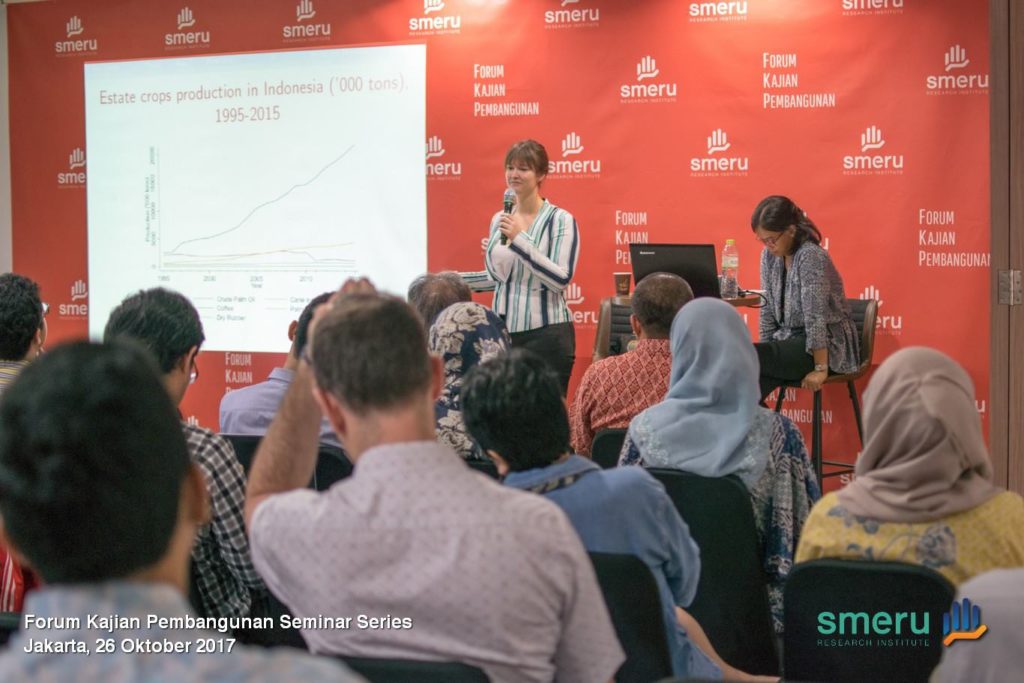On Thursday 26th October 2017, a FKP seminar was hosted by SMERU where Allison Derrick, a PhD candidate from University of Wisconsin-Madison presented her research entitled “Buoyed by the boom? Household consumption during an agricultural export boom”. The underlying hypothesis here is that an agricultural booms and busts have the potential to either help or hurt households especially in countries. The study she conducted specifically looked at the palm oil price boom and bust in Indonesia between 2000 and 2015 with the main question being whether it increase household expenditure in the producing districts around in Indonesia and whether the characteristics of producers matter.
From the data gathered, palm oil price had a generally increasing trend from 2000 up to around 2011 but it has been declining until 2015. However, since before 2000 until 2015, land used to produced oil palm and the number of crude palm oil produced have been steadily increasing. On the other hand, the average household expenditure in the producing districts rises and falls by relatively the same magnitude with the boom and the bust in palm oil prices. Additionally, it should be noted that the magnitude slightly vary dependent on the producer characteristics. For the small plantations, the magnitude of household expenditure changes are the same, but for large plantations, expenditures did not change significantly during either period. While for the new producer districts the increase in household expenditure during the boom is larger. In regards to their specific spending, household spending on education did not change but spending on health increases by more than the total expenditure, but falls again during the bust.
The data collected are in line with current available literature although the literature lack analysis of agricultural booms. The available literature is more on energy and gold while agriculture is more labor intensive and rents are not easily captured, although they are similar in that both are natural resources that exposes the economy to high volatility through volatile global prices. A previous study that focuses on palm oil and its effect on poverty reduction in Indonesia looked at only the boom period between 2000 and 2008.
This research modifies the previous research that used energy export boom and changed it to an agricultural export boom model that has different assumptions about the factor intensity and use price shock instead of resource discovery. The model predicts an increase in return to palm oil producing land, an increase in nominal wage, a decrease in nominal and real return to capital, the expansion of palm oil industry and nontraded sector, and also a contraction of the other traded sector.
The data used was taken from various sources. The household expenditure and other characteristics was taken from National Socio-Economic Survey (Ind: Survei Sosial-Ekonomi Nasional – Susenas) (2000-2015). Producer classification is taken from FAO. Palm oil production and district characteristics is from INDO-DAPOER (2001-2010). Commodity prices was taken from IMF international financial statistics from 1980 until now.
In terms of methods, first, districts are classified and then the model look at dynamic effects by year. After that, the research looks at the producer type and dynamic effects. Then collapse data to boom and bust and differentiate them between producers and non-producers. Afterwards it is further differentiated by plantation size and age.
The limitations of the research are as follows. Firstly it does not account for the intensity of production and only see aggregate changes in a district. Secondly, it does not take into account local CPI changes. Moreover, it focused on short-run estimates, which mean more time is needed to observe long-run effects. Given these limitations, the research brought fourth three key empirical results. Firstly, household spending is more sensitive towards the boom than the bust. Secondly, smallholders are more exposed to price changes while the corporate ones are more insulated. Thirdly, spending on health and education exhibit drastically different behavior. Thus, palm oil production may not be a sustainable poverty reduction strategy due to the reliance of households on a high global price. The research offers a richer theory for the impact of commodity price shocks on household consumption. It emphasizes that structural properties of commodity production matter for predicting the impact of boom and bust.





